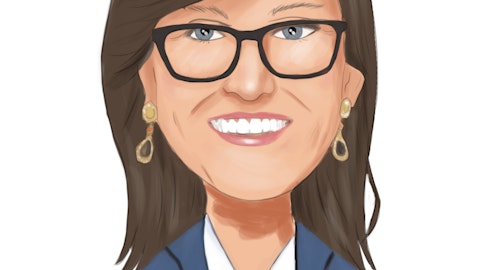Unity Software Inc. (NYSE:U) Q3 2023 Earnings Call Transcript November 9, 2023
Richard Davis: [abrupt start] Today I’m joined by Jim Whitehurst, our CEO, and by Luis Fasoso, our CFO. But before we begin, I want to note that today’s discussion contains forward-looking statements, including statements about goals, business outlook, industry trends, market opportunities, expectations for future financial performance, and similar items, all of which are subject to risks, uncertainties, and assumptions. You can find more information about these risks and uncertainties in the risk factors section of our filings at sec.gov. Actual results may differ and we take no obligation to revise or update any forward-looking statements. Finally, during today’s meeting, we will discuss non-GAAP financial measures. These non-GAAP financial measures are in addition to and not a substitute for or superior to measures of financial performance prepared in accordance with GAAP.
A full reconciliation of GAAP to non-GAAP is available in our shareholder letter and on the sec.gov website. Great. So let me turn the call over to Jim to kind of make some opening comments.

James Whitehurst: All right. Well, thank you. And let me say good afternoon to everyone, and thank you for joining us on today’s call. We released our Q3 earnings today, as well as the shareholder letter that describes our results. I assume you’ve all read that. So let me just highlight three quick points before we get into Q&A. First off, I’ve been at Unity now for about a month, and I have to say I’m so impressed with the passion, both inside the Company and more broadly in our community. And that is unquestionably a good thing that we elicit so much passion from our community. It shows the level of engagement that we have and the importance of the role of Unity in our community. It’s our job now to focus that on the most important task, which is to build a best-in-class platform that helps make creators more successful from start to finish, from design to monetization.
Second, the world has changed, and we’re changing with it. We’ve taken some good first steps to bring expenses down, changing Unity from a money losing to a cash flow positive Company in less than a year. That’s a good first step, but frankly, we’re examining the Company from top to bottom, ensuring that we transform Unity into an even more nimble and focused business. And I’m sure we’ll talk more about that. And third, once we position Unity to succeed, we need to accelerate growth. We’ll get there by focusing on large growing markets, but most importantly, by doubling, if not tripling down on building amazing technology that helps our customers succeed. If we do that, growth and profitability naturally flow from that. So with that, let me turn the call over to Richard.
Richard Davis: Great. Well, thanks a lot. So maybe what we’ll do, which we’ve done in the past, is we kind of get inbound questions during the quarter and things like that. Maybe we’ll kind of hit the two most common questions we often get. We’ll start with Jim, and then we’ll go to Luis, and then we’ll go to open Q&A and things like that. So for Jim, if you kind of step back, what do you see? And I know you’ve been short term here for a month, but maybe it’s fair or not, but what do you see the Company looking like in three to five years? What’s your vision?
See also 30 Most Conservative Countries in the World and their Economic Development and 20 Most Valuable Gambling Companies in the World.
Q&A Session
Follow Unity Software Inc. (NYSE:U)
Follow Unity Software Inc. (NYSE:U)
James Whitehurst: Yeah, sure. And let me start off saying, I had experience in a Company building a business as part of a broad community. So I naturally come back and focus on how we think about community. So if I just put that simply in five years, I want us to be the trusted leader of a community of creators building on our technology. And because of that, we’ll be an indispensable partner for game creators to build, operate, and profit from their creations. That alone is hundreds of billions of dollar market. Secondly, our technology, and this is one of the things coming from enterprise I’ve been so impressed with, is incredibly relevant to enterprises. And so the second piece of that is I’d like to see our technology as the default choice for enterprises and individuals to create and interact with 3D content.
Again, that is a tremendous untapped potential as well. And so if we can do those two things, be an independent defensible partner, kind of a leader in helping game developers and being the 3D visualization technology that the world comes to, that’s a really exciting business.
Richard Davis: Great. And then Luis, it’s addressed to some degree in the shareholder letter, but could you kind of explain some of the key interventions that are being considered?
Luis Visoso: Sure. Thank you, Richard. we started a comprehensive assessment of our product portfolio several weeks ago, and we’re evaluating every product in our portfolio through, I would say, three lenses. First, are we meeting our customer need in a unique way that differentiates us from others? Second, are we able to grow revenue, expand margins, and generate free cash-flow at attractive levels? And third, is the opportunity large enough and sustainable to build a meaningful business over time? And while we’re making great progress in this evaluation and planning, it is still early to share more specifics. Now, what you can expect is that we will be making changes to our product portfolio this quarter in Q4, and we expect the full implementation of the changes to be completed by the end of Q1.
As Jim said, we’re also continuing to adjust our cost structure to improve margins, and this will lead to a reduction in force, a reduction in office locations, which we will be announcing over the next few months. Back to you, Richard.
Richard Davis: Great, thanks very much. Okay, now we can open it up to Q&A from the analysts. So, Thomas, if you can see the people that are in the queue, and we can drop them in there. Maybe we answered all the good questions.
Richard Davis: Oh, there we go. Dylan, yeah, Dylan Becker at William Blair. Thank you very much.
Dylan Becker: Awesome. Hey, guys, thanks. Jim, maybe starting with you, I think in the shareholder letter, obviously there’s a lot of focus on narrowing scope and the focus here, but looking at it a month in, maybe there’s some initiatives underway, but how you’re seeing the business relative, again, to maybe some of your past experiences and the opportunity to drive that efficiency that you’ve done, maybe utilize some of the prior playbook you’ve seen?
James Whitehurst: Yeah, look, thank you, Dylan. A great question. I want to always be careful, not too much drawing parallels, but frankly, there is a lot of parallel to this, and frankly, when I first got to Red Hat, which is Red Hat had a industry-leading product with Red Hat Enterprise Linux, but was spending a tremendous amount of time doing five or six or seven other things. And it’s not just the expense associated with it, it is the management time and attention and more broadly, the clarity of focus throughout the organization that you get from doing fewer things, frankly, where you are winning and have a right to win. And so I do see parallels there, just very, very simply, we’re doing a lot of things and we obviously have a leading share product that’s growing very nicely.
And so, and then there are some extensions off of that, which are actually fit in well with good synergies, but frankly, we’re doing a lot of other things. And so one is just, I think there’s very similar to Red Hat, let’s start off narrowing down, make sure we are on our path to achieving the full potential of our core business before we get too busy doing other things that aren’t directly tied to that. And then number two is just sharpening our execution. I think obviously there’s a natural evolution of companies where you start off, you get kind of product market fit, you’re trying to experiment. And so you’re running a lot of experiments around, you’re less focused on driving effectiveness and efficiency. And I think we’re to the point where market’s voted.
We got a couple of really leading products, whether that’s the engine and runtime, whether that’s our core kind of monetization stack. And we need to focus down, put the right KPIs in place, tighten our belts and execute into those things. And as we do that, we have a solid profitable business that we can scale from these leading positions. And so it is a little similar to Red Hat, both in terms of leading product, but doing a bunch of other things and losing focus and just naturally not being at the point until now of really looking to kind of build an efficient and effective operating model around those things. And so I think those are the two big ones that feel very, very similar. Also equally incredibly passionate, brilliant people who are deeply dedicated in a deeply mission-driven Company.
And so when you have that, your ability to execute when people are aligned and passionate about what you do is just so much easier. And that definitely shared with Red Hat.
Dylan Becker: Sure, awesome. Okay, helpful color there. And then maybe two, I think you guys called out a lot of the synergies you’re seeing within the Grow solution base and the importance of iron source and level play there. But maybe it’s a little early to call out from a product perspective too, but you did mention tightening the integration between kind of create and grow, but how you think about that synergistic value coming together across the platform over time? Thanks.
James Whitehurst: Yes, I’ll start and Luis if you want to add. So, first off, really working to build an operating model that draws value in both kind of data and then across create and grow, I think we can do a better job of doing that. We’ve been working on the integration of just kind of people and things, but really building the flywheel there is an area I think we can kind of double down our focus on, which has a lot of value. The other is just, together, those two things are what drives developer, game developer success. And we’re still a little bit because we’re still in the middle of the integration disjointed and having a single view of our customers. So we can go talk about how we can help them best create value from development all the way through to monetization.





